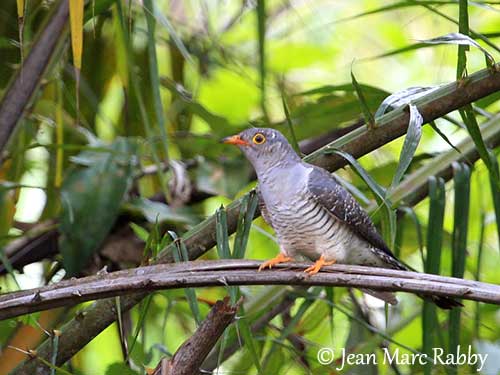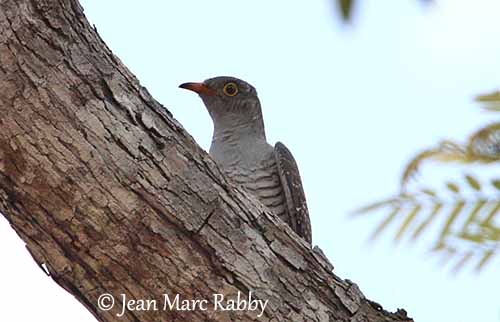
Fr: Coucou africain
Ang: African Cuckoo
All: Afrikanerkuckuck
Esp: Cuco Barbiblanco
Ita: Cuculo africano
Nd: Afrikaanse Koekoek
Sd: Afrikansk gök
Photographer:
Jean Marc Rabby
Des Ailes et des Plumes
Text by Nicole Bouglouan
Sources:
HANDBOOK OF THE BIRDS OF THE WORLD vol 4 by Josep del Hoyo-Andrew Elliott-Jordi Sargatal - Lynx Edicions - ISBN: 8487334229
BIRDS OF THE GAMBIA AND SENEGAL by Clive Barlow and Tim Wacher – Helm Field guides – ISBN: 0713675497
BIRDS OF AFRICA SOUTH OF THE SAHARA by Ian Sinclair and Peter Ryan - Princeton University Press Princeton and Oxford - ISBN: 0691118159
BIRDS OF EAST AFRICA vol 1 by C.A.W. Guggisberg – Mount Kenya Sundries Ltd. – ISBN: 9966889051
Biodiversity Explorer – The Web of Life in Southern Africa
THE AVIANWEB (Sibylle Faye)
African Cuckoo
Cuculus gularis
Cuculiformes Order – Cuculidae Family
INTRODUCTION:
The African Cuckoo is closely related to the Common Cuckoo (Cuculus canorus), and both species were formerly conspecific. They have very similar appearance but quite different calls.
This species is a parasitic cuckoo and it parasitizes mainly the nests of the Fork-tailed Drongo. Like numerous cuckoos, it feeds primarily on hairy caterpillars caught in the foliage. It is usually found in open woodland and Acacia savanna.
The African Cuckoo is an intra-African migrant.
DESCRIPTION OF THE BIRD:
Biometrics:
Length: 32 cm
Weight: 110 g
The adult is a large grey cuckoo very similar to the Common Cuckoo. Only some morphological details are making the difference.
The African Cuckoo has more extensive yellow bill base, barred (not spotted) outer-tail, and more finely barred vent and undertail-coverts. It lacks the rufous morph.
The adult has dark ashy-grey upperparts, including wings and tail, but the rump is paler grey. The longish tail shows broad white barring on upper outer rectrices.
On the underparts, chin, throat and breast are pale grey. Rest of underparts is whitish with well-spaced dark grey barring, less conspicuous towards lower belly and vent. Flanks are finely barred. The undertail is barred with variously spaced markings. The underwing is dark grey with broad white bars.
The female differs by the rufous-tinged throat and upper breast.
Both adults have grey head and greyish-white chin. The bill is yellow with black tip. The eyes are yellow, surrounded by paler yellow eyering. Legs and zygodactylous feet are yellow.
The juvenile has mostly blackish upperparts scalloped with white. Head and underparts are heavily barred black-and-white. It has broad white spots on tail.

RANGE:
The African Cuckoo occurs in Senegal and Gambia, E through N Nigeria to S Sudan, Eritrea, NW Somalia and S to Namibia, Botswana, Zimbabwe and E South Africa.
It is mainly a non-breeding migrant in E Africa.
HABITAT:
The African Cuckoo frequents open woodland and Acacia savanna, and favours the lightly wooded country. It usually avoids the evergreen forest.
CALLS AND SONGS: SOUNDS BY XENO-CANTO
The African Cuckoo differs from the Common Cuckoo by its quite different call, more hoopoe-like “hoop-hoop” but slower and often with more accentuated second syllable. This call is also described as weak and forced dove-like “ou-ou” lacking the initial “c” of the Common Cuckoo’s call.
BEHAVIOUR IN THE WILD:
The African Cuckoo feeds mainly on hairy caterpillars, but it also takes various insects such as Coleoptera, Orthoptera and winged termites. For the latter, it exploits the emergences which occur during the early rains.
It forages among the foliage in trees and shrubs, but sometimes, it can be seen flying to the ground to catch a prey. Like numerous Cuculidae, it also takes eggs and nestlings of other bird species.
The African Cuckoo is a brood parasite and the female lays her egg in the nest of other species, and especially the Fork-tailed Drongo.
Usually, both sexes share the egg-laying process. The female sneaks into the host’s nest while the male distract the owners. She often removes the host’s eggs before laying her own egg.
The courtship displays are unknown, but they are probably similar to those of the Common Cuckoo. The male bobs the head or bows the body, with wings open and drooped while the tail is raised and fanned. This posture displays the plumage pattern. In addition, the male sometimes offers a caterpillar to the female.
The African Cuckoo is an intra-African migrant. It breeds during the rainy season. It arrives with the rain and disappears after breeding. Information about dispersion or migration is currently lacking.
It has pointed wing shape and is a good flier, but it does not migrate over long distances, and probably performs more gliding flight than the Common Cuckoo.

REPRODUCTION OF THIS SPECIES:
The African Cuckoo breeds during the rainy season, and this period varies depending on the range.
As a parasitic cuckoo, it does not build a nest. The host species is usually the Fork-tailed Drongo, and sometimes the Yellow-billed Shrike, and probably some other species too.
The male distracts the hosts while the female lays her egg in their nest. She lays one whitish egg with brownish spots or blotches, similar to the eggs of the Fork-tailed Drongo. She may remove the existing eggs before laying.
The hosts incubate the egg during 11-17 days. The cuckoo chick may eject existing eggs or chicks from the nest if its mother did not make it. The foster parents feed it and it fledges 20-23 days after hatching.
PROTECTION / THREATS / STATUS:
The African Cuckoo is frequent or common throughout its range, although being locally common in South Africa and uncommon in E Africa.
The population size is unknown but it is suspected to be stable, and the African Cuckoo is currently evaluated as Least Concern.